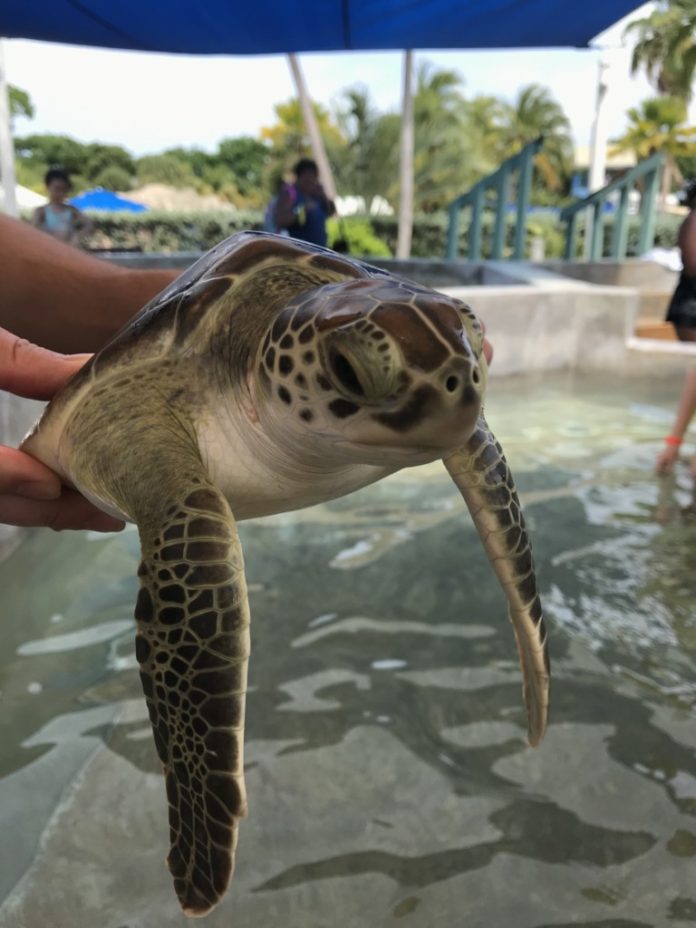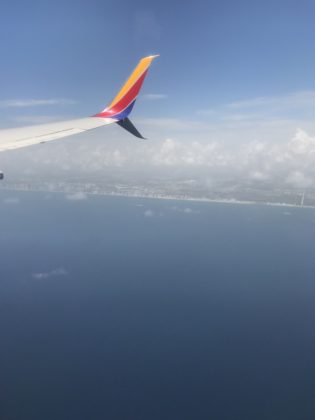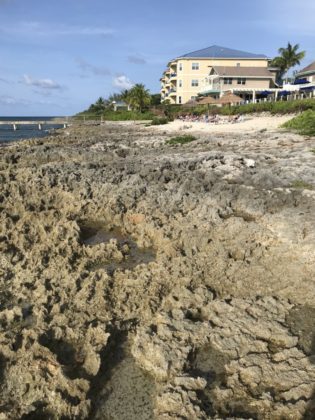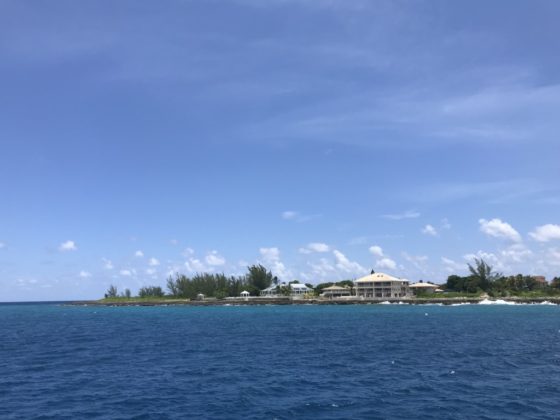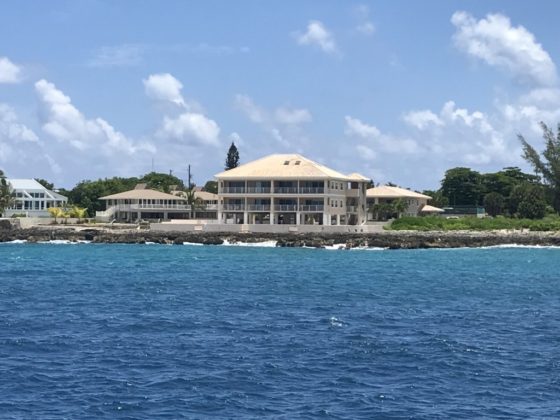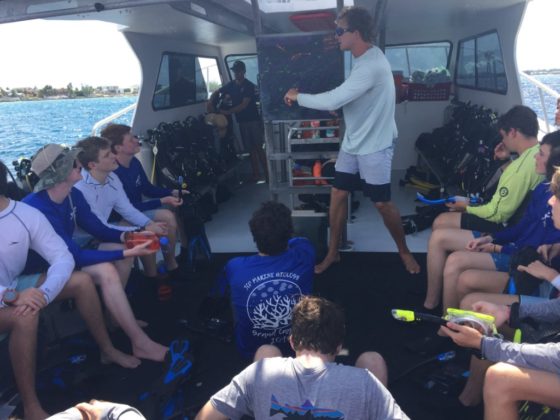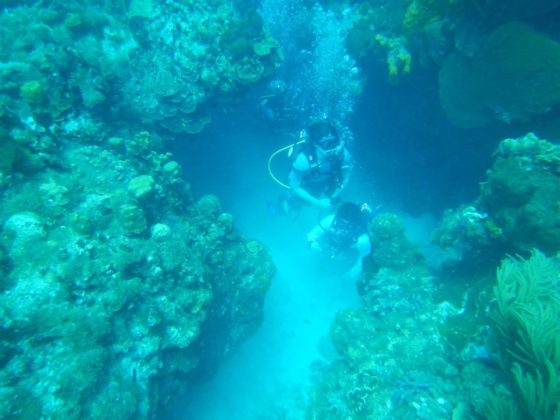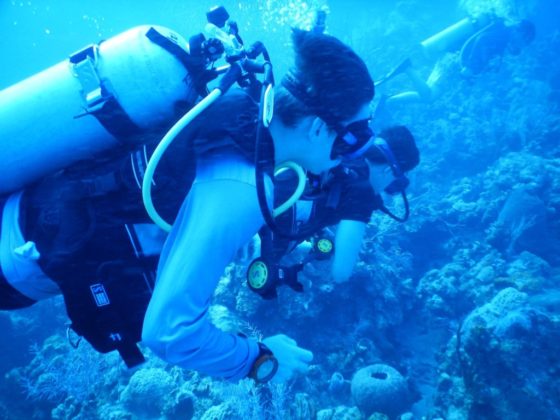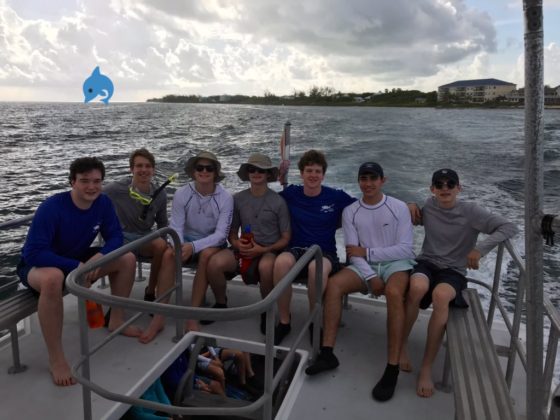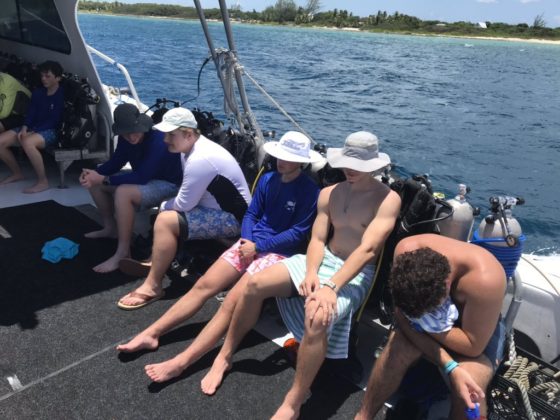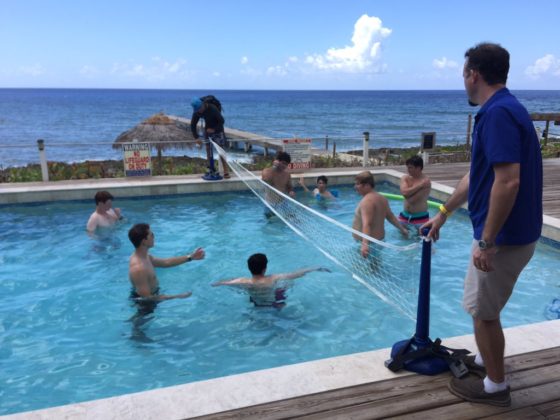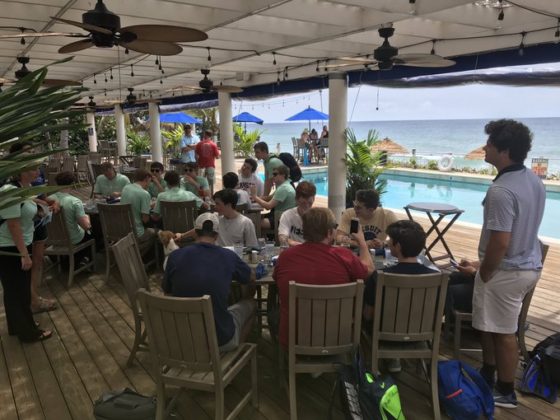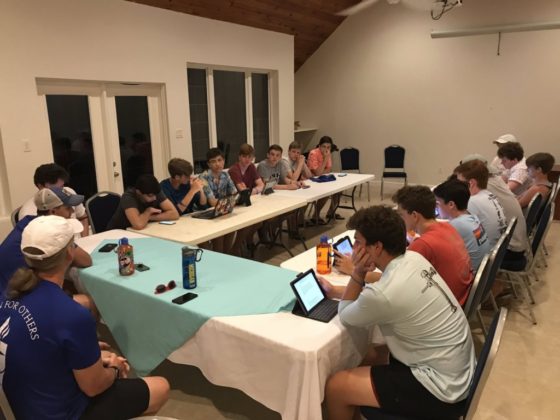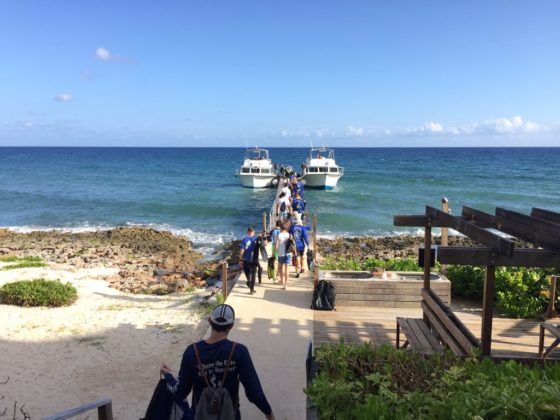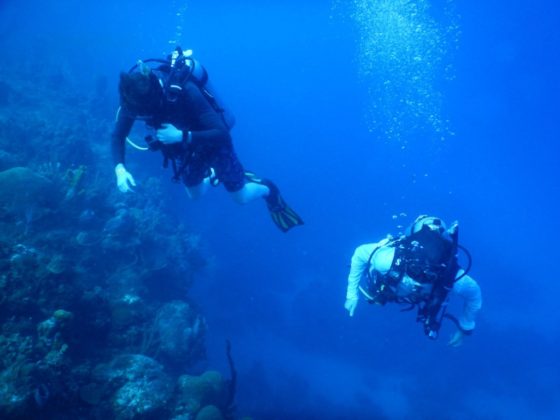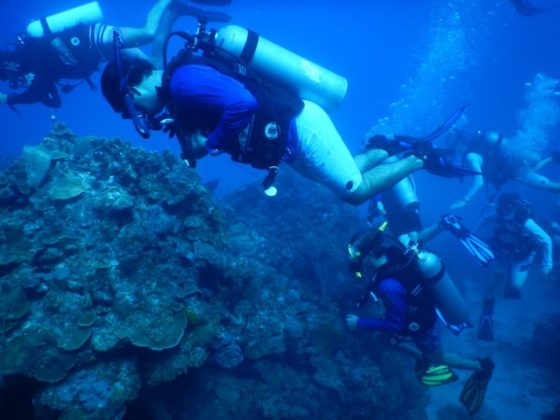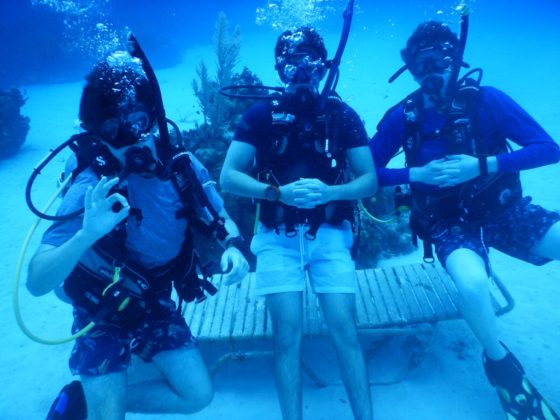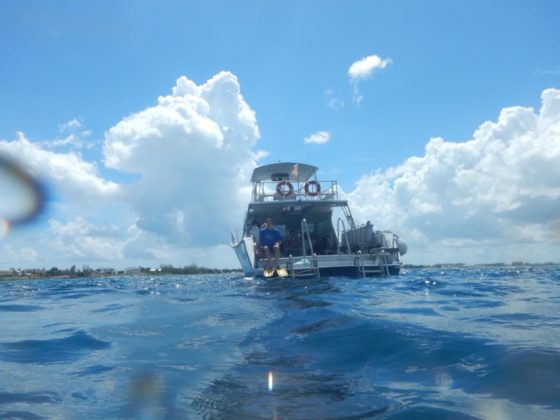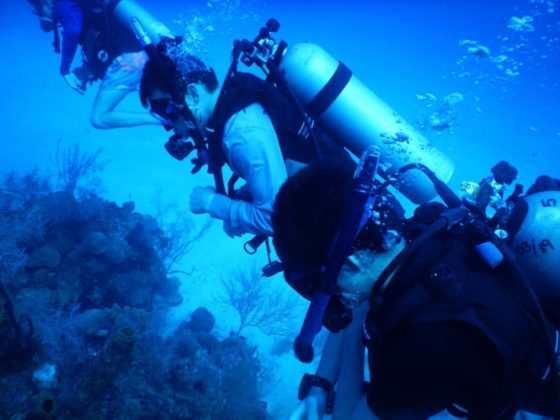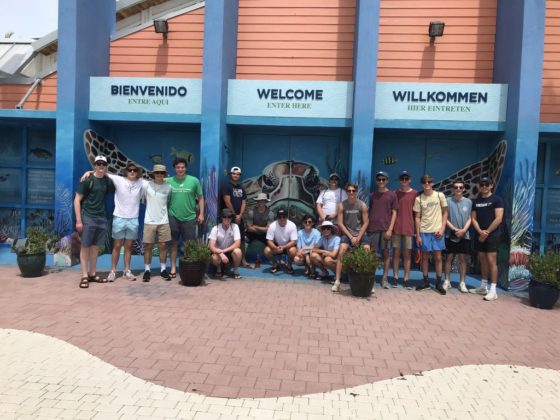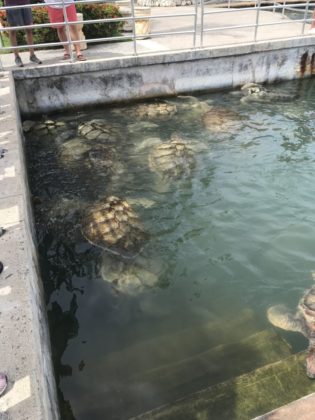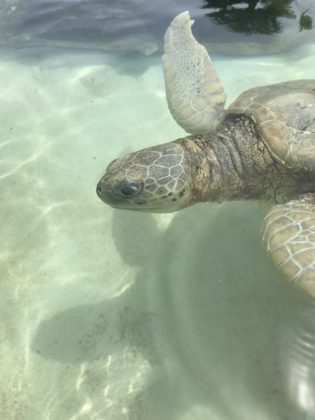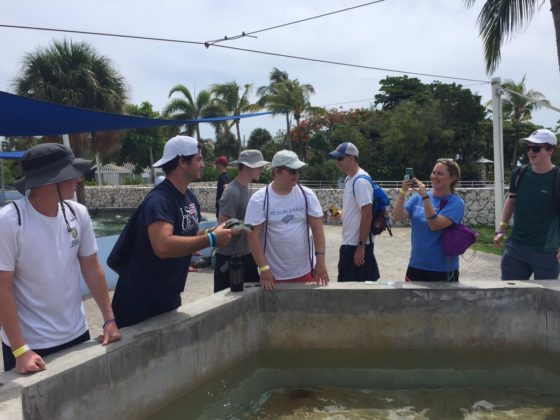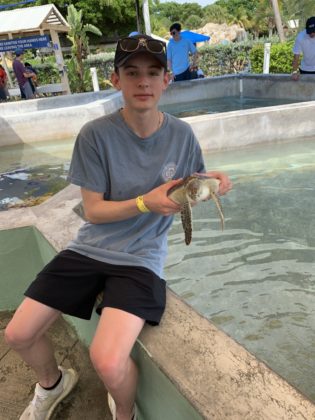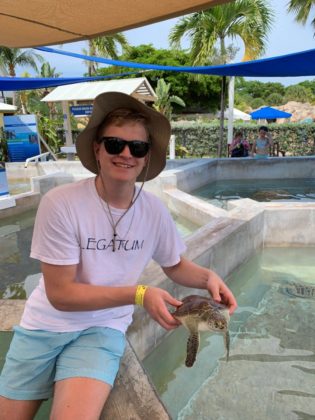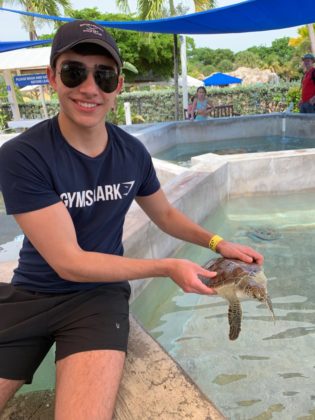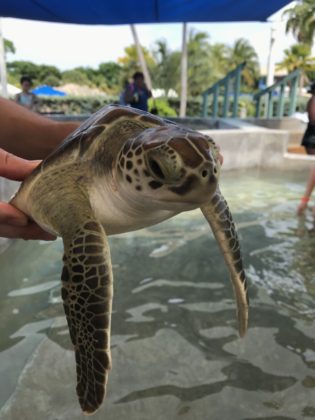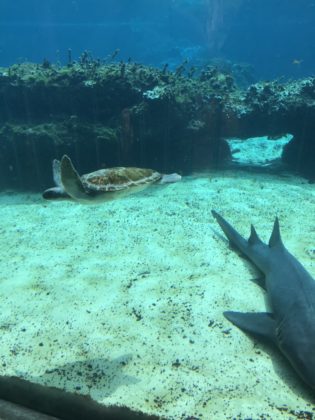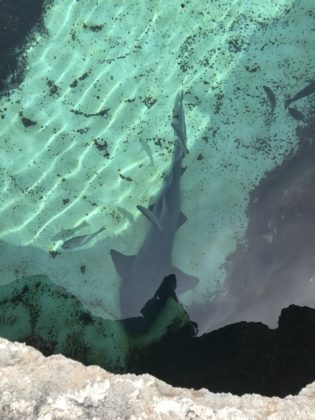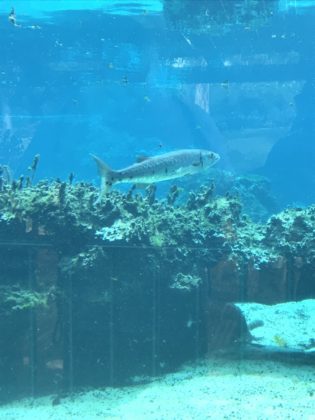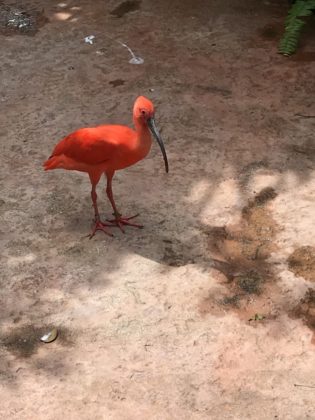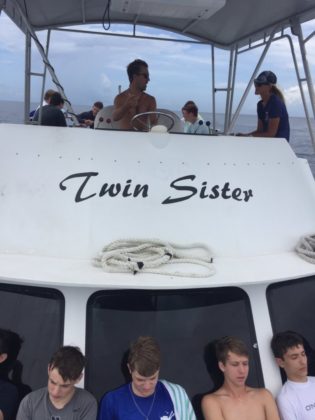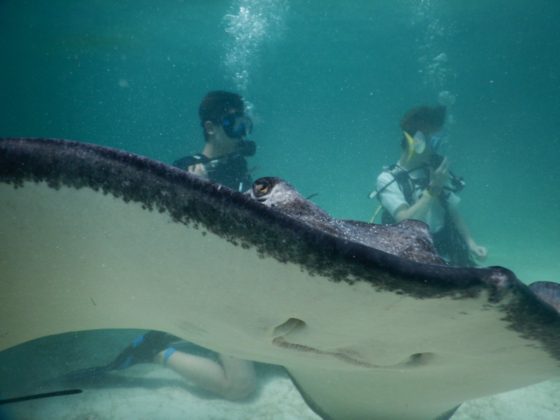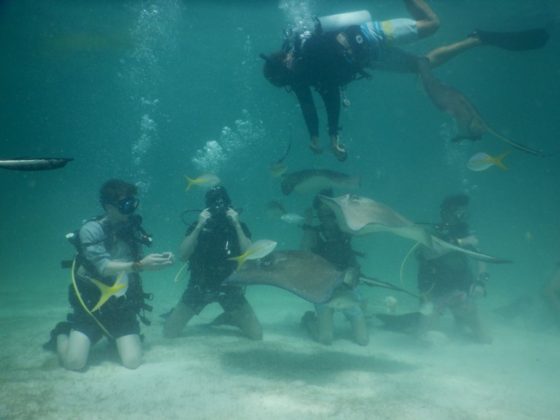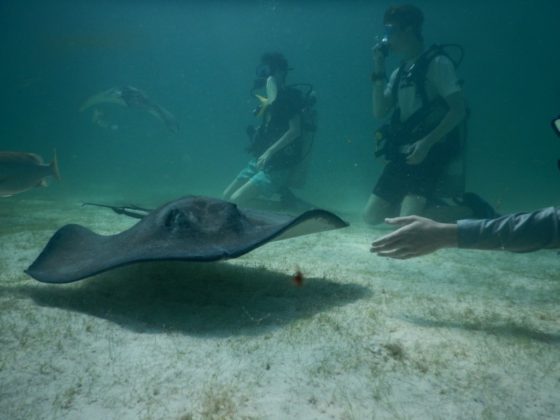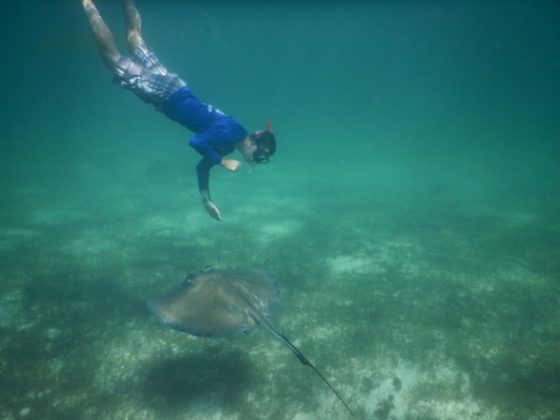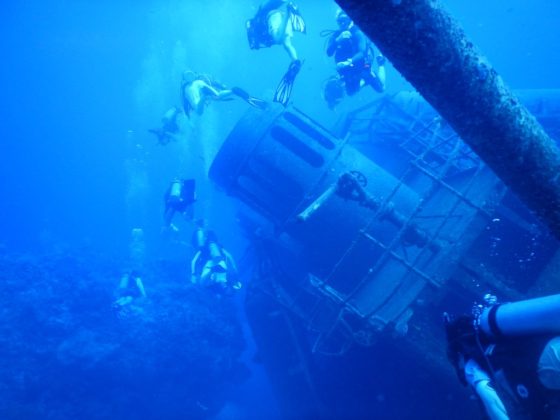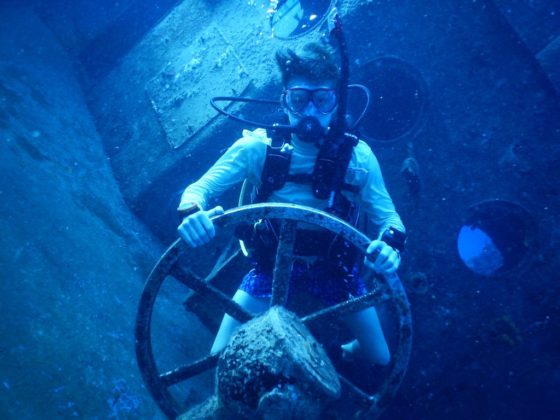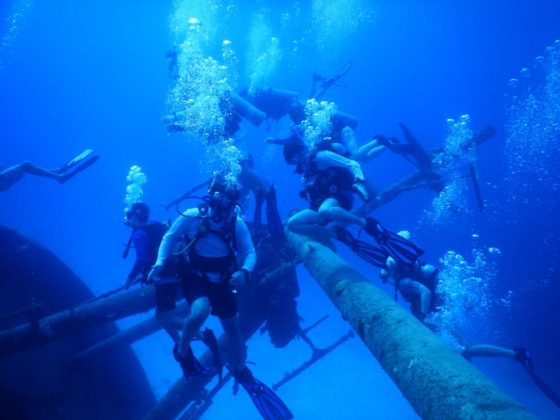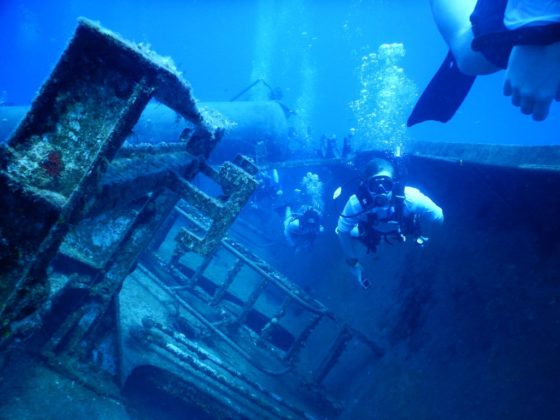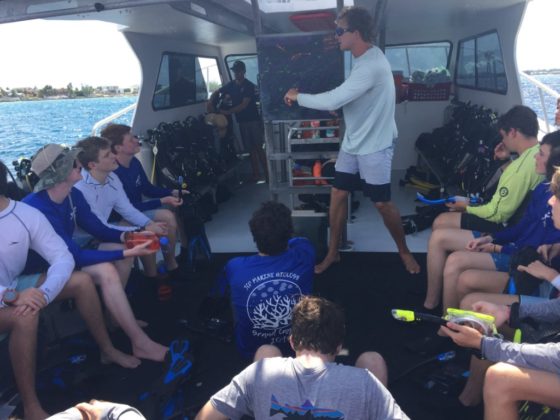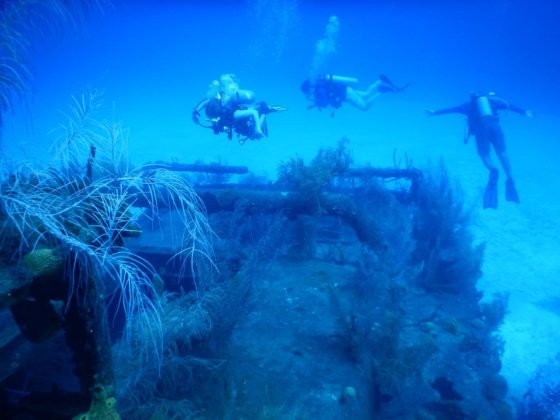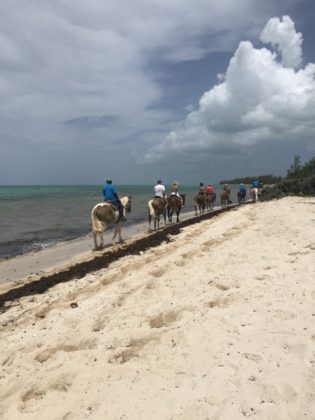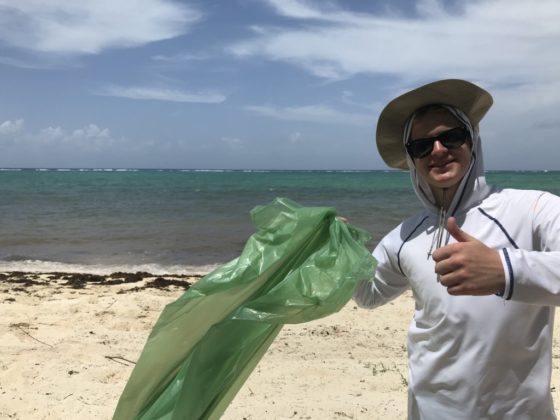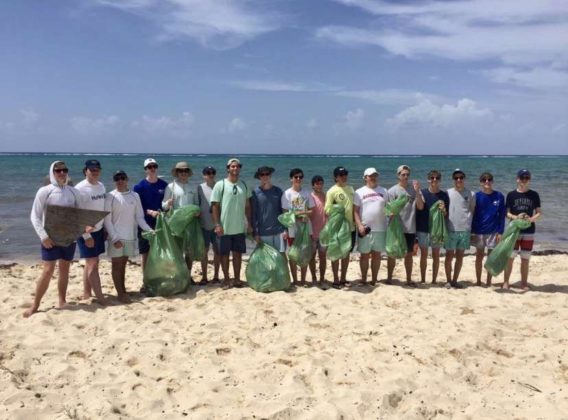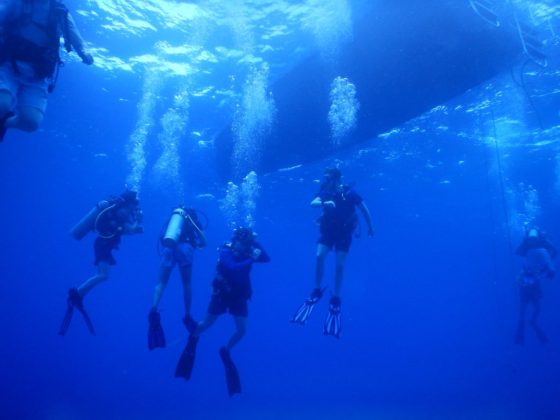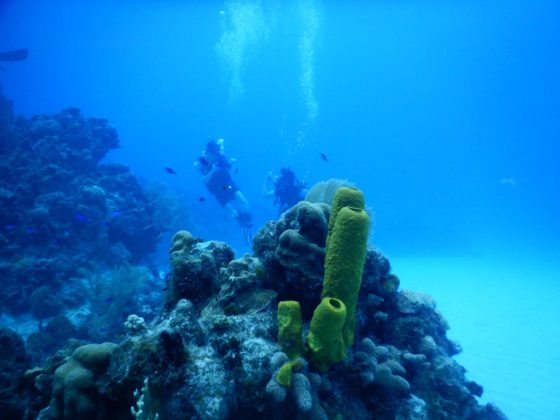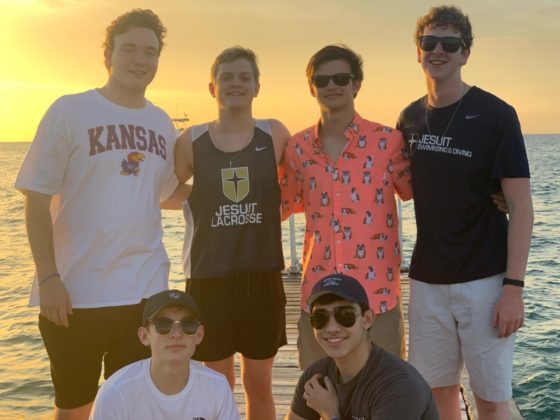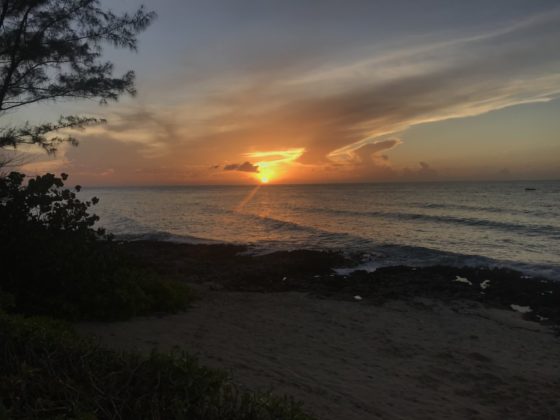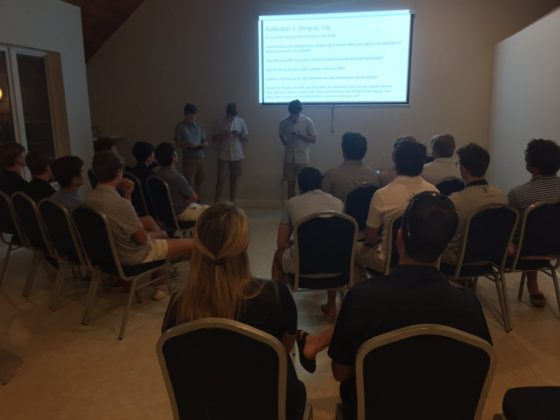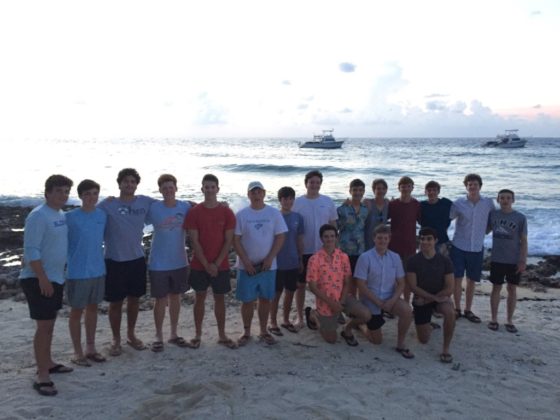This July, the Jesuit marine biology program embarked on its eighth annual scuba diving excursion. After the Virgin Islands were mauled by Hurricane Irma in 2017, the program was left without a dive location. After experimenting in Hawai’i on last year’s trip, this year we traveled to the Grand Caymans, a small island group in the Caribbean. Around 40 students and six teachers traveled to the Cayman Islands to pursue the goal of experiencing and learning about the ocean and the life it fosters. Because of the large number of students in the program, the trip was split into two separate weeks. I, along with some of my fellow marine biology peers, left for the Caymans in the first week while other students waited until the second week.
Pic Gallery
Day 1
I started my day with 3 AM alarm and a groggy trip to the airport. We met with our group, including Dr. Kirby, Dr. Gruninger, Ms. Matthews, and Mr. Marr outside of security as we 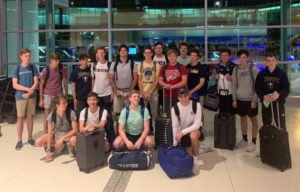 awaited the arrival of the rest. After two flights and a long wait at customs to enter the Caymans, we made it to our dive resort, Cobalt Coast. Once we arrived at the resort, we got settled in, ate lunch, and eventually went snorkeling. The water was violently choppy so it was difficult to get readjusted to snorkeling, since it had been a while since most of us had last snorkeled. The deeper we swam, the more fish we began to see. I quickly noticed a banded butterfly fish hiding in some coral. I was able to identify it by the black and white vertical stripes that run down it’s body. I also saw a four-eyed butterfly fish, whose bright yellow color stood out in the water. We were all ecstatic to finally be in the water and experience the species that we had studied first hand.
awaited the arrival of the rest. After two flights and a long wait at customs to enter the Caymans, we made it to our dive resort, Cobalt Coast. Once we arrived at the resort, we got settled in, ate lunch, and eventually went snorkeling. The water was violently choppy so it was difficult to get readjusted to snorkeling, since it had been a while since most of us had last snorkeled. The deeper we swam, the more fish we began to see. I quickly noticed a banded butterfly fish hiding in some coral. I was able to identify it by the black and white vertical stripes that run down it’s body. I also saw a four-eyed butterfly fish, whose bright yellow color stood out in the water. We were all ecstatic to finally be in the water and experience the species that we had studied first hand.
Day 2
We started our day at 6 AM, feeling extraordinarily tired after a long day of travel. After eating breakfast, we got ready to do our first dives of the trip. We went out to the boat and drove to our first site, where we were briefed about what to expect on the dive. This 35-minute dive 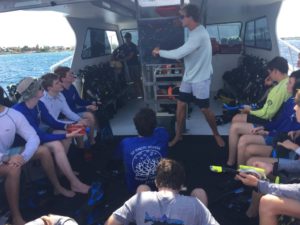 was at a location called the “School House,” where we reached a depth of 60 feet. Even at the deep depths, the water was warm enough to be comfortable without a wetsuit. After this dive, we took a 45 minute break and went to do our second dive. This dive was also 60 feet and was planned to be an hour long dive. In these dives, I saw dozens of species of fish. I saw a sergeant major, a small fish that has a fairly circular body. Its white coloration, vertical black stripes, and yellow color just below the dorsal fin makes it easy to identify. The largest fish I saw on these dives was the Mutton Snapper. It only swam in the open water, as it was too big to fit in many of the smaller holes in the coral. It was very round on the top and flat on the bottom, with a mouth very low on its head and a faded color from silver at the top to a light read near its belly.
was at a location called the “School House,” where we reached a depth of 60 feet. Even at the deep depths, the water was warm enough to be comfortable without a wetsuit. After this dive, we took a 45 minute break and went to do our second dive. This dive was also 60 feet and was planned to be an hour long dive. In these dives, I saw dozens of species of fish. I saw a sergeant major, a small fish that has a fairly circular body. Its white coloration, vertical black stripes, and yellow color just below the dorsal fin makes it easy to identify. The largest fish I saw on these dives was the Mutton Snapper. It only swam in the open water, as it was too big to fit in many of the smaller holes in the coral. It was very round on the top and flat on the bottom, with a mouth very low on its head and a faded color from silver at the top to a light read near its belly.
This dive was our first encounter with the wide variety of Caribbean coral. One of my favorite corals that I saw on this dive was the Colpophyllia natans, also known as the Giant Brain Coral. It is a hermatypic coral, meaning that it is a hard coral that builds reefs by depositing hard calcareous material for its skeleton. It is a large and round coral that has a yellowish color. It got its name the ‘Brain Coral’ because of the patterns on the corals surface resemble the patterns of brain matter.
Day 3
I arose from my slumber at the obscenely early hour of 6 AM, once again. After waking up ![]() and getting dressed, I fueled my body with some eggs, bacon, sausage, and cereal. After that, we boarded the boats and got ready for 2 dives. The first dive at a dive site called “Big Tunnels,” where we reached a maximum depth of 100 feet. The second dive was at a site called “Bonnie’s Arch,” where the maximum depth we reached was 70 feet. Some of the most fascinating and beautiful things that I’ve encountered while diving came during these dives. I had my first experience diving with tarpon, an extremely large fish that became famous from sport-fishing. They were around four feet in length and had large eyes, a reflective, silver color, and large mouths. We also saw a school of horse eye jack. There large eyes, football shaped bodies, silver coloring, and forked tails make them very easy to identify. These dives stunned me, as the immense beauty of the coral reefs was fully displayed by the large coral walls and tight coral caves which we dove through. It gave me an entirely new perspective on coral reefs after seeing the how incredibly gorgeous they were first hand.
and getting dressed, I fueled my body with some eggs, bacon, sausage, and cereal. After that, we boarded the boats and got ready for 2 dives. The first dive at a dive site called “Big Tunnels,” where we reached a maximum depth of 100 feet. The second dive was at a site called “Bonnie’s Arch,” where the maximum depth we reached was 70 feet. Some of the most fascinating and beautiful things that I’ve encountered while diving came during these dives. I had my first experience diving with tarpon, an extremely large fish that became famous from sport-fishing. They were around four feet in length and had large eyes, a reflective, silver color, and large mouths. We also saw a school of horse eye jack. There large eyes, football shaped bodies, silver coloring, and forked tails make them very easy to identify. These dives stunned me, as the immense beauty of the coral reefs was fully displayed by the large coral walls and tight coral caves which we dove through. It gave me an entirely new perspective on coral reefs after seeing the how incredibly gorgeous they were first hand.
Day 4
This morning, we slept in until 7 o’clock and ate breakfast a bit later, a nice change of pace 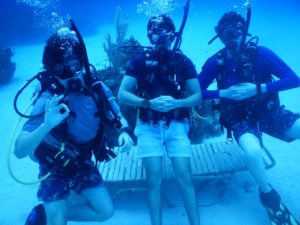 from the three previous days. Following this we boarded our boat, the Twin Sister, and proceeded to our first dive site. The two sites we dove at were called ‘Big Dipper’ and ‘Anchor Chain.’ At Big Dipper we dove to 100 feet and at Anchor Chain we went to only 35 feet. These were two of my favorite dives of the trip so far because of the terrain that we saw and went through. Both of these dives included both sand bottoms and coral reefs, providing the opportunity to see an even wider variety of marine life. At the Big Dipper, while swimming over a sandy area towards the reef, we spotted a lionfish. Lionfish are invasive species and presently a major threat to the reefs and their marine life. They have no natural predators because they are extremely venomous, and their red and white color along with their flowing appendages allow them to blend in with the coral. They are predators that eat almost anything, depleting the food source of the native fish. In the Caymans, if you see one, you are supposed to tell a dive master so they can shoot it with a spear. We also saw lots of garden eels on both dives.
from the three previous days. Following this we boarded our boat, the Twin Sister, and proceeded to our first dive site. The two sites we dove at were called ‘Big Dipper’ and ‘Anchor Chain.’ At Big Dipper we dove to 100 feet and at Anchor Chain we went to only 35 feet. These were two of my favorite dives of the trip so far because of the terrain that we saw and went through. Both of these dives included both sand bottoms and coral reefs, providing the opportunity to see an even wider variety of marine life. At the Big Dipper, while swimming over a sandy area towards the reef, we spotted a lionfish. Lionfish are invasive species and presently a major threat to the reefs and their marine life. They have no natural predators because they are extremely venomous, and their red and white color along with their flowing appendages allow them to blend in with the coral. They are predators that eat almost anything, depleting the food source of the native fish. In the Caymans, if you see one, you are supposed to tell a dive master so they can shoot it with a spear. We also saw lots of garden eels on both dives.
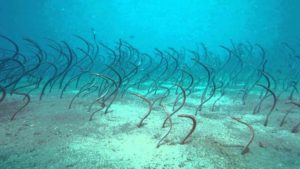
via https://www.twofishdivers.com
Garden eels can be found in large groups in the sand. They are small and skinny and live in holes that they make in the sand. They like to stick their bodies out of the hole to allow nutrients to drift towards them so they have easy access to meals. They are preyed upon by eagle rays, stingrays, hogfish, and other large predators. After the dives, we returned for lunch, a quick rest, and then we went to the turtle center. Here we got to see sea turtles, nurse sharks, birds, a crocodile, and other fish and marine life. I was able to recognize the Green Sea turtle by identifying its prefrontal scales and the smooth scoots on its sides. We also saw nurse sharks, tarpon and barracuda in the predator 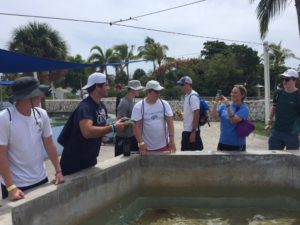 tank. After this, we came back to the house for dinner and we went on a night snorkel around 8 PM. Using flashlights, we scanned for unique marine life in the ink black water. We saw two lobsters that were both longer than a foot, which is very big for Cayman lobsters. Their antennae stuck out very far to help them sense their surroundings better. We also saw two small squid that were using jet propulsion to glide through the water near the sea floor.
tank. After this, we came back to the house for dinner and we went on a night snorkel around 8 PM. Using flashlights, we scanned for unique marine life in the ink black water. We saw two lobsters that were both longer than a foot, which is very big for Cayman lobsters. Their antennae stuck out very far to help them sense their surroundings better. We also saw two small squid that were using jet propulsion to glide through the water near the sea floor.
Day 5
This morning we woke up at 7AM, well rested and ready for a busy day of diving. We ate a hearty serving of breakfast and then boarded our trusty vessel, the Twin Sister. With some help from our reliable dive masters, Bernie and Curtis, we safely made it 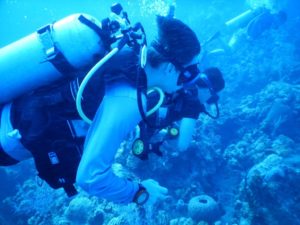 to our first dive site, Hepp’s Pipeline. Here, we embarked on a dive with a maximum depth of 80 feet. On this dive, I saw a large trumpetfish exhibiting a really interesting hunting strategy. First of all, I was able identify the trumpetfish by its long and skinny body, its long ‘snout’, and its upturned mouth. I first saw one hovering along the side of some coral. It then it turned itself on its head, moved into the coral, and changed its color to match that of the coral. It has a very acute sense of memory that allows it to perfectly mimic the color of the coral it’s trying to blend in with. By blending in with the coral, it makes it easy to hunt its prey. It can easily pop out of the coral and surprise any unlucky victim. On our second dive, we went to a site called Spanish Bay. Here, we saw an extremely wide variety of rare wildlife, including lobsters, lionfish, trumpetfish, and juvenile spotted drum fish. We saw two juvenile spotted
to our first dive site, Hepp’s Pipeline. Here, we embarked on a dive with a maximum depth of 80 feet. On this dive, I saw a large trumpetfish exhibiting a really interesting hunting strategy. First of all, I was able identify the trumpetfish by its long and skinny body, its long ‘snout’, and its upturned mouth. I first saw one hovering along the side of some coral. It then it turned itself on its head, moved into the coral, and changed its color to match that of the coral. It has a very acute sense of memory that allows it to perfectly mimic the color of the coral it’s trying to blend in with. By blending in with the coral, it makes it easy to hunt its prey. It can easily pop out of the coral and surprise any unlucky victim. On our second dive, we went to a site called Spanish Bay. Here, we saw an extremely wide variety of rare wildlife, including lobsters, lionfish, trumpetfish, and juvenile spotted drum fish. We saw two juvenile spotted 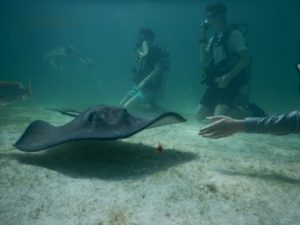 drum hiding in a small cave. I didn’t know how to identify them without some help from Bernie. Now, after seeing them, I know to identify them by their small bodies, their vertical black and white stripes, and their massive u-shaped tails. After the dives, we ate lunch, played some pool volleyball, and rested before heading to Stingray City. At Stingray City, we all sat in a large circle on the seafloor, and the dive masters used bottles full of squid to attract southern stingrays. Their mouths have no teeth but instead two hard plates that act like grindstones that they use to grind up their food. The top of their skin was very rough but on their undersides they felt very smooth. Bernie compared their undersides to a “wet mushroom,” and I found that comparison to be extremely accurate.
drum hiding in a small cave. I didn’t know how to identify them without some help from Bernie. Now, after seeing them, I know to identify them by their small bodies, their vertical black and white stripes, and their massive u-shaped tails. After the dives, we ate lunch, played some pool volleyball, and rested before heading to Stingray City. At Stingray City, we all sat in a large circle on the seafloor, and the dive masters used bottles full of squid to attract southern stingrays. Their mouths have no teeth but instead two hard plates that act like grindstones that they use to grind up their food. The top of their skin was very rough but on their undersides they felt very smooth. Bernie compared their undersides to a “wet mushroom,” and I found that comparison to be extremely accurate.
Day 6

Following a great night of blogging the previous day, I woke up this morning and got ready for our second to last day of diving. We ate some grub and got ready for our first dive of the day. The first dive sight was at the shipwreck of the ex-USS Kittiwake, a 251 foot boat. It was commissioned from the 1940s to the 1990s and was intended to be a submarine rescue vessels. However, it ironically destroyed as many submarines as it saved. When they sank the Kittiwake, it was originally standing straight up, but after a hurricane, it was knocked mostly onto its side. On this dive, we didn’t see as many fish as in the reef, but there was still a wide variety of species. My favorite species that I saw on this dive was the barracuda. It was pretty easy to identify because of its long, skinny, silver body, forked tail, large eyes, and its mouth full of razor sharp teeth. It isn’t very afraid of humans, so it stalked me for a little bit, which felt very eerie, especially because of all its exposed teeth. The second dive was at a location called Doc Poulsen. This dive site was at another ship wreck, a 90 foot boat that was sunk in the 1970s. It was named after the first doctor in the island, who was renowned for giving all the dive masters free medical examinations.
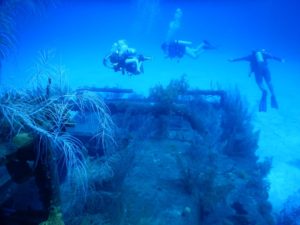
The boat was totally covered in coral growth and algae. I saw lots of fish living on and in the boat. We also saw around ten conchs crawling around in the sand near the shipwreck. Conchs are large mollusks that live inside of a spiral shell. They use their muscles to stick to objects or sand and slide around. Conchs are herbivores that eat algae and other small marine plants. They are a very popular prey among larger predators, as they are somewhat vulnerable to be snatched up and sucked out of their shell since they are very slow. After the dives, we ate, swam, and then went to our beach for cleanup.
Day 7
This morning we gloomily woke up around 7AM, disappointed that our last day of diving was already upon us. We ate breakfast and got ready to dive around 7:45. For our first dive of the day we went to a site called Sand Hole. Here, we followed the edge of a mini-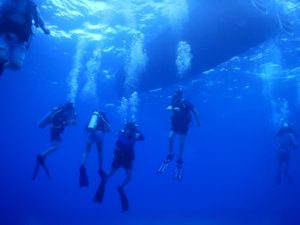 wall, which was packed with coral, sponges, and fish life. It had a sheer drop off to a sandy bottom. Because of the large amounts of sponges, while following the mini-wall we saw two hawksbill sea turtles snacking on some of the sponge. I knew it was a hawksbill turtle because of the jagged lateral scoots, the beak, and two prefrontal scales. It used its flippers to grip onto the edge of the mini wall to eat the sponge. Its sharp beak is used to tear bits of sponge away. As we approached it, it didn’t seem very intimidated by our presence. It moved from sponge to sponge, slowly working around the wall, until it eventually swam away. The second dive was at a location a location called Ocean Pointe. This dive site was very close to our resort and, once again, it was a mini-wall. We saw lots of squirrelfish on this dive, tucked under ledges of coral. They have large eyes, spiny dorsal fins, and a red and white color. Prior to the dive, Bernie mentioned the possibility of seeing a lemon ray. A lemon ray is a small ray
wall, which was packed with coral, sponges, and fish life. It had a sheer drop off to a sandy bottom. Because of the large amounts of sponges, while following the mini-wall we saw two hawksbill sea turtles snacking on some of the sponge. I knew it was a hawksbill turtle because of the jagged lateral scoots, the beak, and two prefrontal scales. It used its flippers to grip onto the edge of the mini wall to eat the sponge. Its sharp beak is used to tear bits of sponge away. As we approached it, it didn’t seem very intimidated by our presence. It moved from sponge to sponge, slowly working around the wall, until it eventually swam away. The second dive was at a location a location called Ocean Pointe. This dive site was very close to our resort and, once again, it was a mini-wall. We saw lots of squirrelfish on this dive, tucked under ledges of coral. They have large eyes, spiny dorsal fins, and a red and white color. Prior to the dive, Bernie mentioned the possibility of seeing a lemon ray. A lemon ray is a small ray 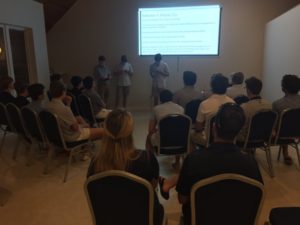 that is a sandy yellow color. It has large white spots around the outside of its body and is covered with smaller black dots as well. It camouflages itself in the sand to hide from other animals. We ended up seeing a lemon ray near the end of the dive. It was somewhat buried in the sand and was very hard to spot out because of its color. After our last dive, we went back to the resort and played some pool volleyball and ate lunch. Then, we got our stuff ready to go, ate dinner, and had our student-led prayer service. The prayer service was a great way to reflect over our experiences and to help put into perspective how luck we all are to have an opportunity like this.
that is a sandy yellow color. It has large white spots around the outside of its body and is covered with smaller black dots as well. It camouflages itself in the sand to hide from other animals. We ended up seeing a lemon ray near the end of the dive. It was somewhat buried in the sand and was very hard to spot out because of its color. After our last dive, we went back to the resort and played some pool volleyball and ate lunch. Then, we got our stuff ready to go, ate dinner, and had our student-led prayer service. The prayer service was a great way to reflect over our experiences and to help put into perspective how luck we all are to have an opportunity like this.
My Opinion
The Marine Biology class and trip have been the highlights of my summer for the past two years. Learning about the ocean creatures and the adversity they face, then experiencing it first hand is an amazing experience that not many people have. The Grand Caymans hosted a wider variety of wildlife than I’d ever experienced, and I am extremely grateful to have had the opportunity to witness it. From wild chickens to iguanas, hermit crabs, stingrays, crocodiles, and turtles, I have never seen anywhere similar to the Grand Caymans. I would highly recommend this course to anyone interested in the ocean and aquatic life because experiences like this are once-in-a-lifetime. With increasing ocean acidification and coral bleaching, we might not be able to see the ocean’s full beauty in the future.
Stay tuned to The Roundup for recaps of more Jesuit academic, service, and spiritual excursions!


